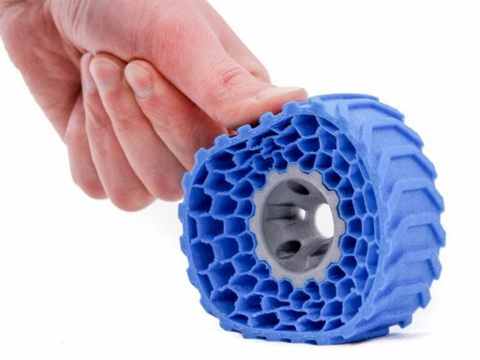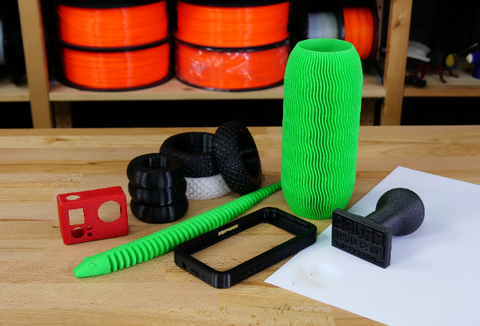Flexible PLA (Polylactic Acid) and TPU (Thermoplastic Polyurethane) are two popular flexible filaments, each offering distinct advantages and applications. While both materials are known for their flexibility and durability, they differ in terms of synthesis, physicochemical properties, and practical uses.
This article explores these differences, providing a detailed comparison to help you select the best filament for your 3D printing needs. Whether you're a hobbyist or a professional, understanding the nuances of Flexible PLA and TPU will enhance your printing experience and project success.
Understanding the Differences Between Flexible PLA and TPU
When it comes to flexibility, Flexible PLA offers a good balance between rigidity and elasticity, making it ideal for projects that require a certain level of malleability. On the other hand, TPU stands out for its superior flexibility and durability, making it suitable for applications where impact resistance and soft textures are essential.

In terms of print settings, Flexible PLA typically requires lower printing temperatures compared to TPU. While TPU is known for its flexibility, it can be a bit trickier to print due to its elasticity, requiring slower print speeds and adjusting retraction settings accordingly.
Pros and Cons of Flexible PLA
Pros:
●Ease of Printing: Flexible PLA is generally easier to print than TPU, with lower temperature requirements and less warping.
●Compatibility: Works well with most standard FDM printers without the need for significant adjustments.
●Versatility: Offers a good balance of rigidity and flexibility, suitable for moderately flexible parts.
●Strength: Flexible PLA can handle shape changes when pressure is applied, snapping back to its original form once the pressure is removed. This feature makes it different from regular PLA, which tends to be brittle. However, flexible PLA is not ideal for supporting weight as it tends to bend.
Cons:
●Durability: Flexible PLA is less durable than TPU and can become brittle over time, especially when exposed to UV light.
●Limited Flexibility: While flexible, it doesn't match the extreme elasticity of TPU, limiting its use in highly demanding applications.
●Hygroscopy: Flexible PLA is hygroscopic, meaning it absorbs moisture from the air over time. This moisture can negatively affect the filament's flexibility and print quality, causing issues like warping and surface defects. Proper storage is crucial to maintaining its properties and ensuring consistent printing results.
Pros and Cons of TPU
Pros:
●Superior Flexibility and Durability: TPU offers excellent elasticity and impact resistance, making it suitable for high-stress applications.
●Wide Application Range: Its toughness makes it ideal for automotive parts, protective gear, and other functional components.
Cons:
●Printing Difficulty: TPU can be challenging to print due to its elasticity, requiring precise settings and slower print speeds.
●Printer Compatibility: Not all 3D printers can handle TPU effectively without modifications or specific extruder setups.
Applications and Use Cases for Flexible PLA and TPU
When it comes to selecting the right material for your 3D printing projects, understanding the specific applications and use cases for Flexible PLA and TPU is crucial.

Flexible PLA, with its ease of printing and softer texture, is ideal for creating prototypes, wearables, and accessories that require a balance of flexibility and sturdiness. On the other hand, TPU's exceptional durability and elasticity make it a top choice for producing functional parts, protective gear, and impact-resistant components across various industries, including automotive, aerospace, and sports equipment manufacturing.
Flexible PLA

Prototypes: Flexible PLA is perfect for creating prototypes such as bendable hinges, flexible joints, and soft-touch components.
Wearables: Ideal for producing items like wristbands, custom-fit earplugs, and flexible watch straps due to its comfort and moderate flexibility.
Accessories: Used for items like phone cases, soft grips for tools, and protective covers for electronics, offering a balance of sturdiness and flexibility.
TPU

Functional Parts: TPU is great for automotive components like air intake ducts, vibration dampening mounts, and seals, providing durability and elasticity.
Protective Gear: Commonly used for making durable items such as protective phone cases, impact-resistant sports gear, and flexible knee pads.
Impact-Resistant Components: Ideal for aerospace applications, including shock-absorbing parts, flexible gaskets, and robust seals that require high impact resistance.
Post Processing
Flexible PLA is generally easier to post-process with standard methods. Its supports can be manually removed, and the material sands easily with regular sandpaper. In contrast, TPU's supports are more challenging to remove due to its flexibility and cannot be sanded effectively. Some users employ a hair dryer or gentle heat to carefully melt away stringing on TPU prints.
Painting either flexible filament requires using flexible paints specifically formulated to flex without cracking, ensuring the finish remains intact under stress.
Conclusion: Making the Best Choice for Your 3D Printing Needs
In conclusion, both Flexible PLA and TPU offer unique advantages and considerations for your 3D printing projects. By carefully analyzing the specific requirements, flexibility levels, and intended applications of your designs, you can make an informed decision on which material best suits your needs.
Remember to prioritize mechanical properties, durability, and printability when evaluating the materials. Experimenting with test prints and seeking advice from experienced users are valuable steps in determining the ideal material for your project.
By weighing these factors and considering real-world applications, you can ensure that your 3D printed creations achieve the desired performance and quality. Choose wisely to bring your innovative ideas to life effectively.

